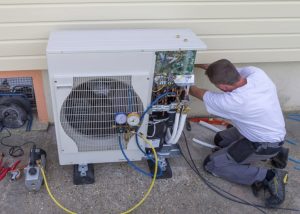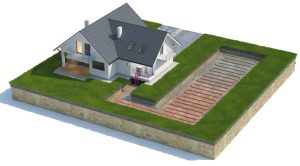If you are looking to upgrade your heating system, heat pumps may be perfect for you. They can save you on costs, reduce your carbon footprint, and even provide financial benefits thanks to some of the fantastic incentives. But before you commit, you should look at heat pump installation and what it includes. The following info should help you to decide if this is the right option for you.
What type of system to choose?
What you will notice when you start looking at heat pumps is there are two major types; air source and ground source. There are some important differences in how they work. This has an impact on the installation and performance.
The first thing you should do is compare air and ground source systems to decide which you want to go for. Generally air pumps are the easiest to install but you must ensure you have enough space outside the property for the unit. It is also important to note that overall they are slightly less efficient.
Ground source pipes are naturally trickier to install because you need to bury the pipes. This requires excavation and space for them. The benefit is these systems are more efficient.
Air source heat pump installation
 If you decide to choose an air source system the first thing you will need to do is decide where to put the main unit. The installer will generally offer advice and recommendations here. You will usually have the choice of placing it on the ground or mounting it on a wall. The latter can be a good space saving option if floorspace is limited.
If you decide to choose an air source system the first thing you will need to do is decide where to put the main unit. The installer will generally offer advice and recommendations here. You will usually have the choice of placing it on the ground or mounting it on a wall. The latter can be a good space saving option if floorspace is limited.
It is important to keep in mind that the main unit needs to be somewhere with shelter from heavy rain and high winds. You should also make sure it is out of the way so that there is no risk of tampering or vandalism. There should be sufficient clearance around the unit to allow air to enter it and make it easy to maintain.
Keep in mind that the system will have two sections; one outside and a second within the property. You must make sure there is easy accessibility and enough clearance in both areas. You must also provide access to the property to complete the heat pump installation.
The installer will begin by fitting both the internal and external unit. Once they are mounted safely they will connect all hoses and pipes, and wire the compressor. Next they will insulate both units. Then the last step is to connect to your heating system. If necessary the work may also involve upgrading radiators and installing underfloor heating.
Ground source heat pump installation
 Installing a ground source system is more complex. To start with you need to make sure you have enough space to install the pipes in the ground. If you have a large garden or lots of land around the property, you should be able to lay the pipes horizontally. If you lack space you may still be able to get this kind of system, but you will need a deep bore to install the pipes vertically. You must ensure the ground is appropriate for this though.
Installing a ground source system is more complex. To start with you need to make sure you have enough space to install the pipes in the ground. If you have a large garden or lots of land around the property, you should be able to lay the pipes horizontally. If you lack space you may still be able to get this kind of system, but you will need a deep bore to install the pipes vertically. You must ensure the ground is appropriate for this though.
Whatever option you choose, excavating to install the pipes can be a little disruptive. You need to ensure the installers can get any equipment and plant in place.
There can be an issue here in some parts of the UK too. Usually you won’t need planning permission for heat pump installation. However, if it is a conservation area or a listed building, you may require it. So, it is best to check before you do anything.
Once the pipes are installed the installer will fit the main heat pump unit inside your property. Then they will connect the outside feed to this. Finally, the unit will need to connect to your current heating system. If any upgrades are necessary, including new radiators and underfloor heating, it should be done before this connection.
Think about insulation
When you choose heat pump installation, whether it is air or ground source, you need to understand the importance of insulation. Both systems generate heat much slower than a traditional boiler. As a result, they can take a little longer to warm up. This can take even more time if you don’t insulate the property properly. The heat can also escape much faster if you don’t have good insulation.
Ideally what you should do is get cavity wall insulation or a similar system that will stop heat escaping through the walls. Plus, you should have high quality windows with double or even triple glazing to keep more heat in the property. A huge amount will escape your property through the roof too. So, loft insulation is a must have.
It is also a good idea to look at the age of your property. Older ones may not have very good floor insulation. It could simply be boards over a concrete slab or a void. If so, insulating the floors can be really beneficial.
Speak to us about services
If you are thinking about your heating and want to upgrade to a heat pump, we can help you to find installers across the UK. They will offer fantastic services for great prices. Plus, you can look at things like grants to help pay for the new system and installation. There are also incentives such as the RHI that can earn you money for the performance of the system.
Heat pump installation will become more and more popular in the next few years, so it is definitely worth looking at now. You can contact Warm today for quotes and to find a local installer.



